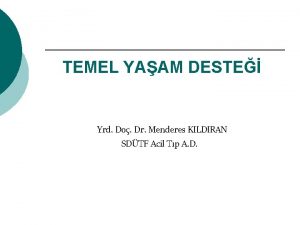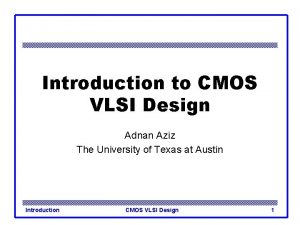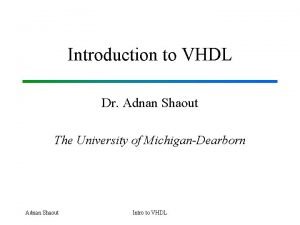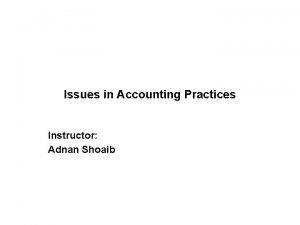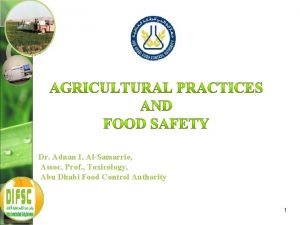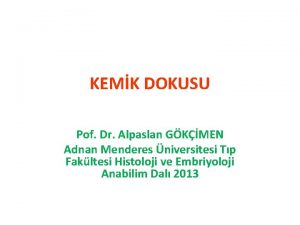ADNAN MENDERES UNIVERSITY Department of Food Engineering FE



























- Slides: 27

ADNAN MENDERES UNIVERSITY Department of Food Engineering FE 206 Food Microbiology I Lecture #1 Cisem Bulut Albayrak, Ph. D.

FE 206 Food Microbiology I • Section II • Tuesdays • Thursdays • Lecture 08: 30 -10: 15 • Lab 10: 30 -12: 15 FE 206 Food Microbiology I 2

Textbook • Doyle and Buchanan, Food Microbiology: Fundamentals and Frontiers, 2013, 4 th ed. ASM Press, ISBN: 978 -1555816261 • Available in University Library as e-book FE 206 Food Microbiology I 3

Grading Grades will be determined as follows: • Laboratory grade: 20% • Quizzes: 10 % • Homeworks: 10% • Midterm: 20% • Participation: 10% • Final exam: 30% Total: 100% Grade 90 -100 85 -90 75 -84 70 -74 60 -69 55 -59 50 -54 0 -49 Letter AA BA BB CB CC DC DD FF Laboratory will be graded by: Laboratory reports: 70 % Lab Exam: 30 % FE 206 Food Microbiology I 4

Attendance • Student attendance is mandatory and students must attend all sessions • Small tolerance may be shown • At least 70 % attendance in lectures and 80% in labs are expected FE 206 Food Microbiology I 5

Binomial nomenclature • Saccharomyces cerevisiae • Escherichia coli • Homo sapiens • S. cerevisiae • E. coli • H. sapiens FE 206 Food Microbiology I 6

Types of Microorganisms in Food • Important Microorganisms in Foods – Fungi – Bacteria – Parasites – Viruses – Algae – Prions FE 206 Food Microbiology I 7

Fungus - Fungi • Chytridiomycetes-Members are found in soil, fresh water, and saline estuaries. • Zygomycetes- fungi that reproduce sexually by forming zygospores • Ascomycetes • Basidiomycetes • Deuteromycetes (Fungi Imperfecti): No known sexual growth FE 206 Food Microbiology I 8

Fungus physiology and structure • Most fungi are multicellular, forming a network of hyphae (sing. hypha) • Hyphae that extend above the surface can produce asexual spores called conidia (sing. conidium) – Conidia are often pigmented and resistant to drying • Hyphae form compact tufts called mycelia • Most fungal cell walls are made of chitin FE 206 Food Microbiology I 9

Conidium (spore) Conidia (spores) Germination Conidiophore Aerial hyphae Subsurface Hyphae FE 206 Food Microbiology I 10

FE 206 Food Microbiology I 11

Fungal Diseases • Fungi can cause disease (mycosis) in plants and animals – Mycoses in humans range in severity from "athlete's foot" to histoplasmosis FE 206 Food Microbiology I 12

Fungal Reproduction and Phylogeny • Asexual reproduction in three forms – Growth and spread of hyphal filaments – Asexual production of spores – Simple cell division (budding yeasts) • Some fungi produce spores as a result of sexual reproduction – Sexual spores can originate from the fusion of two haploid cells to form a diploid cell (ascospores, basidiospores, zygospores) – Spores are resistant to drying, heating, freezing, and chemicals FE 206 Food Microbiology I 13

Ascomycetes • Key genera: Saccharomyces, Aspergillus, Penicillium, Microsporum, Morchella • Around 50, 000 species of molds, yeasts, an plant parasites • Also known as (aka) Sac fungi FE 206 Food Microbiology I 14

Budding Yeast Saccharomyces cerevisiae budding Time-lapse movie https: //www. youtube. com/watch? v=Fc. V 1 ydls 9 hg FE 206 Food Microbiology I 15

Basidiomycetes • Key genera: Agaricus, Amanita • Over 30, 000 described species • Many are recognizable as mushrooms and toadstools – Also yeasts and pathogens of plants and humans • Undergo both vegetative and sexual reproduction FE 206 Food Microbiology I 16

Gills FE 206 Food Microbiology I 17

Zygomycetes • Key genera: Rhizopus, Mucor, Encephalitozoon – Known primarily for food spoilage – Commonly found in soil and decaying plant material – All are coenocytic (multi nuclei) – Sexual spores are called zygospores • Rhizopus stolonifer (black bread mold) is representative • Microsporidia: unicellular, obligate parasites – Often infect immune-compromised individuals FE 206 Food Microbiology I 18

Rhizopus stolonifer Microsporidia FE 206 Food Microbiology I 19

Important Bacterial Groups • Lactic acid bacteria (LAB) – Gram (+), non-sporulating rods/cocci, produce lactic acid – Lactobacillus, Lactococcus • Acetic acid bacteria – Gram (-), obligate aerobic, chemoorganotrophic – Acetobacter • Butyric acid bacteria – Spore forming anaerobes – Clostridium butyricum FE 206 Food Microbiology I 20

Important Bacterial Groups • • • Proteolytic bacteria Lipolytic bacteria Thermophilic bacteria Psychrophilic bacteria Halophilic bacteria Sporeformers FE 206 Food Microbiology I 21

Sources of Microorganisms in Foods • Water – Water used in production – Washwater • Plants and Plant Products – Human pathogens from contaminated soil, water – Mold from soil FE 206 Food Microbiology I 22

Sources of Microorganisms in Foods • Food Utensils and Packaging Materials – Open served foods • Intestinal Tract of the Human and Animals – Pathogens – E. coli, Salmonella – Candida – Enteroviruses FE 206 Food Microbiology I 23

Sources of Microorganisms in Foods • Food Handlers – Personal hygiene • Food Ingredients – Chemicals – Spores • Sewage!!! FE 206 Food Microbiology I 24

Sources of Microorganisms in Foods • Animals, Birds, and Fish – Natural flora of animals • Air, Dust, and Soil – Bacterial spores – Fungus spores • Miscellaneous Sources • Animal feeds, Rodents, Insects FE 206 Food Microbiology I 25

Primary Sources of Microorganisms • • • Pathogenic Escherichia coli – intestine Salmonella – intestine, poultry, eggs Campylobacter jejuni – poultry Staphylococcus aureus – nasal cavity Streptococcus pyogenes – nasal cavity Listeria monocytogenes – cheese, milk, fish Bacillus cereus – starchy foods, rice, pasta Brucella – raw milk and products Clostridium perfringens – soil FE 206 Food Microbiology I 26

Resources • Brock Biology of Microorganisms, Pearson FE 206 Food Microbiology I 27
 Ege haritası
Ege haritası Menderes kıldıran
Menderes kıldıran Menderes sargın
Menderes sargın Department of information engineering university of padova
Department of information engineering university of padova Department of information engineering university of padova
Department of information engineering university of padova University of sargodha engineering department
University of sargodha engineering department Adnan gashi
Adnan gashi A liar shepherd story for class 9
A liar shepherd story for class 9 Adnan akman
Adnan akman Adnan çiftçibaşı
Adnan çiftçibaşı Adnan dhahir
Adnan dhahir Adnan aziz tengku faridah harris
Adnan aziz tengku faridah harris Dr adnan budak
Dr adnan budak Adnan akay
Adnan akay Adnan syed good qualities
Adnan syed good qualities Adnan textile
Adnan textile Karen guan
Karen guan Omar hamdan lives in tabuk.
Omar hamdan lives in tabuk. Adnan shaout
Adnan shaout Dr adnan alam
Dr adnan alam Adnan çiftçibaşı
Adnan çiftçibaşı Adnan levent yaldıran
Adnan levent yaldıran Adnan badran
Adnan badran Prof dr adnan tezel
Prof dr adnan tezel Amfisilin
Amfisilin St louis revenue ias
St louis revenue ias Abu adnan foods
Abu adnan foods Nur adnan
Nur adnan

